DO-IT News October 2019

Volume 27, Issue 4
Below are the articles of the DO-IT News October 2019 newsletter. These articles can also be seen all on one page at the Full Newsletter option.
2019 Trailblazer Award Winners
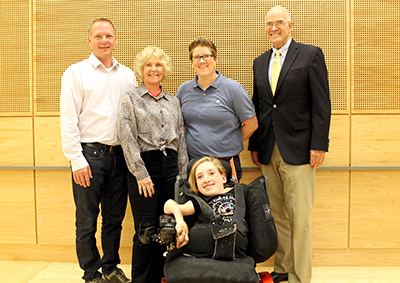
Scott Bellman and Sheryl Burgstahler (left) presented the Trailblazer Award to Bree Callahan, Lee Bassett, and Vanessa Link.
The DO‑IT Trailblazer award highlights DO‑IT community members who forge new pathways that benefit others. Through their hard work, they have changed the way the world views people with disabilities and have increased the potential of people with disabilities to succeed in college, careers, and community life. Congratulations to this year’s honorees!
Bree Callahan is a longtime ally of DO-IT participants, collaborator on DO-IT projects, mentor to DO-IT staff, and member of the DO-IT Advisory Board. She currently serves as the ADA/Section 504 Coordinator for the University of Washington (UW), after working for six years as the Director of UW Disability Resources for Students. She has completed work on two state legislative task forces that examine barriers for students with disabilities transitioning to Washington State higher education institutions. She’s served as president of the Washington Association on Postsecondary Education and Disability (WAPED) and as the chair of the standing committee on technology of the Association on Higher Education and Disabilities (AHEAD).
Lee Bassett, as a member of the DO-IT Advisory Board, has used his knowledge garnered from his many years as a special education professional to help students with disabilities. Lee has recruited qualified students from across Washington State to apply to the DO-IT Scholars program. His career has included classroom teaching, vocational evaluation, district administration, research and development, and professional development of educators. He spent most of his career with the Seattle Public Schools and later joined the Washington Research Institute as a senior researcher. After retiring, he continued working with Casey Family Programs leaders to develop and disseminate a model for college programs to better serve students formerly in foster care.
Vanessa Link, 2014 DO-IT Scholar and now DO-IT Ambassador, is a leader in the community through her disability advocacy and mentorship of younger Scholars. Vanessa graduated from Skagit Valley College with an associate degree and now attends the University of Washington where she is pursuing a degree in disability studies. Since 2016 she has worked at Rooted in Rights designing products for disability rights organizations all over the country. A recent project that focused on what it is like to navigate Seattle using a wheelchair was featured in the Seattle Times and other media outlets. Her advocacy for inclusive and accessible environments is paving the way for future generations.
To read about previous DO-IT Trailblazers, visit Trailblazers.
DO-IT's Newest Program, AccessISL
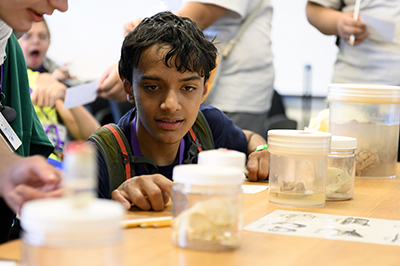
The University of Washington’s (UW) DO-IT Center and Museology Program are collaborating on a newly funded two-year Access to Informal STEM Learning for Participants with Disabilities (AccessISL) project. It is funded by the National Science Foundation Advancing Informal STEM Learning (AISL) Pilots and Feasibility Studies program (Grant #DRL-1906147). The grant will support efforts to develop a capacity building model for making informal science learning (ISL) opportunities more welcoming and accessible to individuals with disabilities. This project will also prepare the UW for the submission of a larger AISL grant proposal.
DO-IT Director Sheryl Burgstahler said “We are excited about the potential AccessISL has to increase opportunities for people with disabilities to learn about science through museums, science centers, and other informal science programs.”
The project will help faculty and ISL personnel increase knowledge, skills, and actions to make ISL programs, facilities, courses, and resources more welcoming and accessible to participants with disabilities and embed relevant practices within their work. The project will also engage postsecondary STEM students with disabilities and museology students and increase knowledge and skills in advocating for ISL offerings that are welcoming and accessible to everyone, including those with a wide variety of disabilities, as well as encourage individuals with disabilities to pursue careers in ISL.
Dr. Meena Selvakumar states “The Museology Program is excited to integrate learnings and practices from the AccessISL project into our pedagogy. We believe this will have a positive impact on our emerging museum professionals as they go on to be agents of change in the field.”
Staff of informal science education programs, educators, and other stakeholders are invited to join the AISL Community of Practice (CoP). The CoP provides opportunities for participants associated with ISL programs to share best practices, form collaborations, and highlight project activities. Learn more online.
Phase I Scholars Share What They Learned
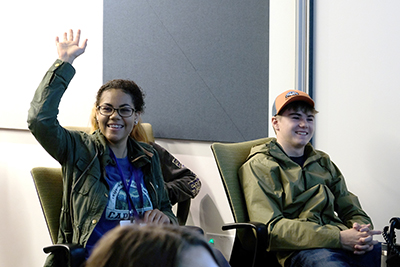
Each summer, the DO-IT Scholars program hosts 45 high school and college students with disabilities on the UW campus, where they learn about technology, self-advocacy, college-preparation, and disability culture. During the 2019 Summer Study, first-year students offered to share what they learned this year. Some highlights include the following:
- How to request accommodations from Disability Resources for Students
- What different accommodations there are, and what might pertain to me
- Planning is very important in college
- How to work with professors
- There are a variety of resources on campus I can use
- University of Washington is a big campus, and I might prefer a smaller campus
- Getting to know everyone helped me make friends and connections for my future
- There are lots of cool accessibility features in smart phones and computers
- Microsoft has a lot of cool accessibility features for gaming
- Websites can be very accessible.
- How to work in HTML
- Bowling can be fun and accessible
- There are options for living accessibly and independently
- It’s ok to be different and just be me
Summer Study: What Do Phase I Scholars Do?
DO‑IT Phase I Scholars participate in a two-week, live-in Summer Study session on the UW Seattle campus. They learn about college life; explore online resources; interact with peers, staff, and mentors; and have fun. The DO‑IT Scholars program started in 1993 as an experimental project for teens with disabilities nationwide. It is currently open to Washington State teens and is supported by the State of Washington, and the Microsoft Corporation.
Adaptive Sports: An Opportunity Behind the Scenes
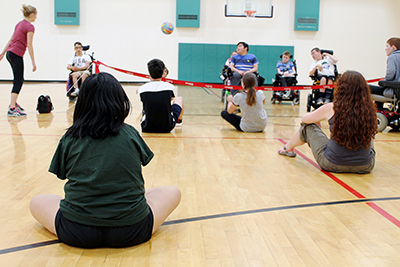
A basketball player goes for a layup. A soccer player spins past an opponent. Two rugby players collide, fighting for the ball. When you read these statements, do you imagine a game with players standing and running? What if I told you that I was describing adaptive sports? Would that influence how you saw the situation? Nearly one in five people in the US have a disability, yet disability sports are rarely televised and lack the prominence of their abled counterparts. If adaptive sports were featured more often, there would be a growth in acceptance for people with disabilities.
Generally defined, adaptive sports are sports that are modified to allow people with physical and sometimes mental disabilities to participate. Almost every sport, and many other athletic recreational activities, has an adaptive counterpart.
One common example is wheelchair soccer, also referred to as power soccer. It’s known as the first competitive power chair sport, and has an Official US Federation, competitive leagues, and even a World Cup. In January 2005, representatives from seven countries got together to form the International Powerchair Football Association (IPFA). Nowadays, over 250 teams compete under the IPFA banner. Power soccer is also officially listed in the Olympics. Wheelchair soccer follows most of the same rules as non-adaptive soccer. However, there are a few key differences. Power soccer is played on a basketball court with teams consisting of four players and the ball must be moved by a player’s chair, not their hands or feet. Team USA currently holds the Power Soccer World Championship.
Another popular example is wheelchair basketball. The rules of wheelchair basketball are very similar to those of non-adaptive basketball, with just a few changes around the methods for dribbling, traveling, and types of fouls. Wheelchair basketball also uses a different type of chair than people use day to day, which is designed to not fall over easily. Wheelchair basketball has a very passionate following—many Scholars in the DO-IT program have played the sport, including one of the authors of this article, Sam.
Despite the many sports available to persons with disabilities, many people do not know about them. These sports are relatively unknown outside of the disability community. Often people with disabilities can miss out on opportunities because these sports aren’t commonly in our media.
We want to make a call for action to more publicly support and acknowledge adaptive sports. Writers can feature these sports, activists and politicians can create change, and television networks can showcase games. Adaptive sports are not so different from the “norm,” so why shouldn’t they be just as featured? It will take a collective effort to surmount this issue, but perhaps, with a concerted push, we can give adaptive sports the prominence that they deserve.
If you have a disability and are interested in participating in an adaptive sport, look for local teams. In the Seattle area, check out Seattle Adaptive Sports.
Planetarium: Our Digital Trip Through the Universe
During the 2019 Summer Study DO-IT program, we had the unique experience of going to the UW planetarium. When we arrived, we were escorted to a large circular room with a long bench along the outside. The room was dimly lit and set the mood for exploring outer space. Several projectors around the room projected images on the domed ceiling, displaying the entire night sky.
In the presentation, we learned about our solar system and the individual planets within it. We even went beyond our solar system, and at the end of our presentation, we zoomed out to where we could get a view of the whole known universe. The technology enabled us to zoom through the sky and make it appear as though the stars were coming towards us. We even flew through Jupiter and saw all its moons. Our presenter was an astronomy student who was very passionate and great at making astronomy more accessible to the average person. Instead of using complex scientific words that we might not understand, he clearly explained each new term and welcomed any questions we had. One of the most interesting facts that we learned was that there may be different forms of life on planets or moons that do not require water to sustain them. The presenter explained that although scientists have a vast knowledge of outer space, they are far from knowing everything. He emphasized the importance of research and the continuous study of our galaxy.
This was one of our favorite sessions. The experience zooming through the stars and planets is unlike anything we have been able to experience, even in school. The visual sensation was like flying through space, and it felt like you were really there. We all came out of the planetarium more educated and informed about intergalactic sciences. Everyone was able to learn something, it was a comfortable learning atmosphere, and the technology paired with an engaging speaker made it a mind-blowing experience.
DO-IT: A Community Environment
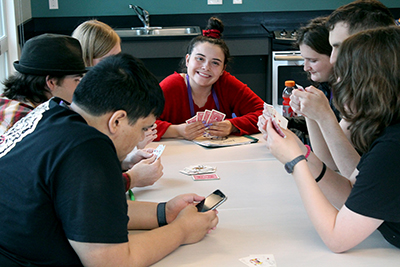
In life there is no cavalry to save you when the treatment that you receive is different from everyone else, but a targeted mentoring program just might do the trick. DO-IT Scholars strive to become truly sensitive to the navigation of their disabilities as aspiring college students, but sometimes learning how to navigate each other is the most important aspect of success—with camaraderie, so much is possible.
Being a Phase I Scholar can be stressful, lonely, and confusing when you first arrive. You’re away from home with all new people, unsure of what’s to come. For a lot of us, this is the first time being away from our families, since most summer camps and programs either can’t handle our disabilities or think we are too much of a liability. Being with people, especially people you don’t know, all day, every day, can escalate anxieties.
All the staff and Interns try to make you feel included and welcome, but we all retain some level of anxiety, especially before getting to know the other Scholars. Often large group activities and icebreakers that are meant to allow people to get to know each other can have the opposite effect those of us with anxiety. It can be helpful to introduce yourself to people and show genuine interest to learn more about them.
We interviewed Intern Emma on how she became more comfortable and got involved when coming to DO-IT Summer Study.
Q: “How did you feel as a Phase I, awkward, excited, left out?”
A: “When I was a Phase I, I was really shy. I felt out of place. But once I started to get to know everyone else, I felt better… but it was also hard being away from home for the first time for two weeks.”
Q: “What was one thing that made a difference in making you feel like part of the group at DO-IT?”
A: “On the first day, my roommate Anna got up and said, ‘let’s introduce ourselves to the group.’ She pushed me to get out there and meet the others, making sure I didn’t just sit by myself.”
Q: “Do you feel more comfortable coming back as a Phase II Scholar or an Intern?”
A: “My Intern year, because now I’ve known the people in my group for two years. However, once I figured out what DO-IT really stood for and that they were here to help us succeed, I felt like I became a part of the community.”
Q: “Do you feel like DO-IT has helped you become your best self?”
A: “Yes, because I feel more comfortable with having my disability after going through this program because everybody is the same in the fact that they are different.”
Emma’s experience really showcases how just having someone to look out for you can really help you feel like part of a community. It is also really helpful to know that everybody feels nervous their first year; some people just show it more than others.
The Zoo
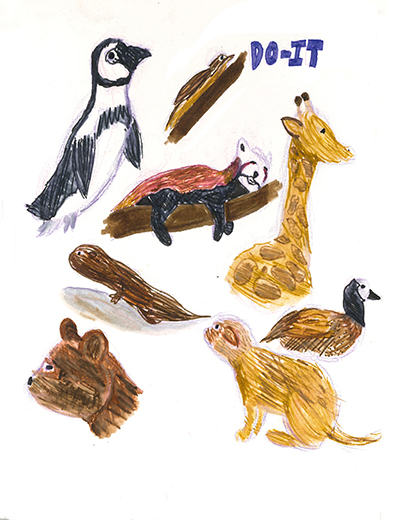
We visited the Woodland Park Zoo on Sunday, July 21. It was very hot out. We started our adventure at the south entrance and made our way up the main loop towards the tropical rainforest exhibits.
We first came across the ring-tail lemurs. They seemed to be sleeping, until after a few minutes they began to stir, groom, and stare at us from a shaded area atop a hill. In the exhibit next door, we saw red ruffed lemurs lazily lounging in the sun on some low hanging branches over a stream.
As we continued, we visited the den of the jaguar, who was prowling about and wondering around the enclosure. We also got to see the gorilla exhibit, where we saw one of the gorillas lying asleep. When we got to the gorilla’s exhibit, we were very surprised and sad to find out that the mountain gorilla is critically endangered; there are only around 1,000 mountain gorillas left in the wild. It was cool to see one in person at the zoo.
After we were done visiting with the gorillas, we passed by the penguin exhibit by the west entrance. There were also seagulls and a great crane hanging out. At this point, we had worked up an appetite and decided to grab lunch.
We enjoyed seeing all the animals about on a “lazy” Sunday, and overall liked our trip to the Woodland Park Zoo. This was a small insight into our trip to the Woodland Park Zoo.
National Park Accessibility
Although many of America’s National Parks have accessibility features for those with disabilities, the main National Park Service website leaves it up to each park to share their own accessibility information and has a mix of information on which parks are accessible, leaving it up to each park’s discretion on whether to include this information.
The main website directs you to find relevant information concerning accessibility on the “Plan Your Visit” feature of each individual park’s website. Some of the national park pages did not provide this critical information, while others gave the information in helpful detail. For example, the Great Smoky Mountains National Park in North Carolina and Tennessee had a whole page on accessibility, including detailed information on how to access the visitors center and camp/picnic grounds and information on park-wide facilities, including parking permits, amphitheaters, auto tours, camping, horse camps, and trails. While the sites that include this level of detail are great, not having the ability to quickly search which National Parks are accessible by using the “Find a Park” feature on the main website adds an additional barrier for people with disabilities. Every park page should contain detailed information about accessibility to ensure equal rights and access.
We also learned about the “Access Passport” permit, which allows free entry into the park. In order to obtain this, go to a local ranger station and bring some form of ID along with diagnostic documentation from a physician. Any US citizen with a permanent disability may obtain one. For more information about the Access Pass, see About the Access Pass (in PDF) from the U.S. Fish & Wildlife Service.
Microsoft Trip
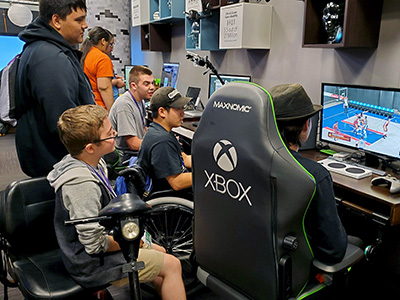
On the first Friday of Summer Study, we took a trip to the Microsoft campus and participated in some engaging activities. First, DO-IT Scholars split into small groups to design a robotic dog that could aid people with disabilities. One common idea was that the dog could detect objects and sounds nearby and notify its owner in various ways. This activity simulated how an innovative company like Microsoft creates and designs new products.
After that, we had a presentation about Microsoft and how its products have accessibility tools to help people with disabilities. Next, we listened and asked questions to a panel with Microsoft employees who have a disability. A few of them have been a part of the DO-IT program. They discussed what designers, engineers, and program managers do as a team and explained their journeys and struggles and how Microsoft has helped them continue their work.
For lunch, Microsoft provided us with a taco bar, which was really nice. We were treated like employees for the day and had many drink options available. It is definitely a great perk of working at Microsoft.
After lunch, our group headed across campus to the Xbox Inclusive Tech Lab. The goal of the lab is to make sure everyone can play games. We learned and talked about the Xbox Adaptive Controller, which is for people who have difficulty playing with a normal controller. Bryce, who works at the lab, showed us some videos of people using the Xbox Adaptive Controller to show how it can help someone with a disability that makes it hard to hold a regular game controller. A regular Xbox controller can pair up with one of the adaptive controllers to work as one whole controller. The adaptive controller also can connect to many different customizable switches. We listened to a 3D surround sound system, which helps people who are deaf or hard of hearing. It brings a whole new level to movies, TV, and music. After the presentation, everyone was allowed to play video games on Xbox consoles and PCs using many types of controllers. We chose to play Minecraft on the PC, which was fun. Other Scholars chose to play different games, such as soccer and other sports. We had a great experience at Microsoft.
Working with Phase I Scholars in the Classroom
This year at Summer Study we got to help the Phase I Scholars in the classroom, where they would work on projects, participate in sessions, and practice using their assistive technology during the day. We ensured that classes ran smoothly by answering questions and helping the Scholars complete their website.
We learned that as Interns, we had to be patient when working with the Scholars. Sometimes we would have to explain something in multiple ways or repeatedly keep people on track with their work. We also jumped in to help where we could. Towards the end of the second week we also helped with their written projects by being interviewed and brainstorming.
Our favorite parts were getting to know the Scholars, helping teach, and seeing them learn. It was different going through the classes as observers. Our internship gave us a deeper understanding of the activities during Summer Study.
Summer Study: What Do Phase II Scholars Do?
Phase II Scholars return to the UW Seattle campus for their second Summer Study. They meet the Phase I Scholars, learn about college life and career preparation, and participate in a one-week workshop with postsecondary instructors.
Disability Advocacy with Rooted in Rights
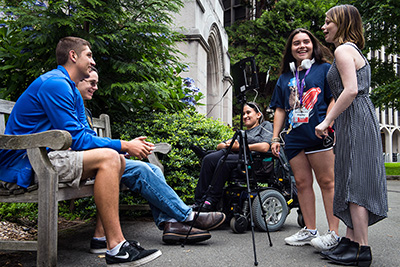
During Summer Study we were able to help with the Phase II workshop with Rooted in Rights (RiR), an organization that creates web content such as videos and blogs to challenge the stigma of disability. To prepare for the workshop, we learned the basics of video editing, which was much more fun than we expected. The Scholars in the RiR workshop had a lot of fun learning how to make exciting and educational YouTube videos.
For four days we helped the Scholars complete their amazing videos. With the direction of the talented RiR staff, we edited our videos using Adobe Rush and shot our videos with a tripod and iPad. The RiR staff were very helpful, accommodating, diligent, and committed to creating quality content that will change the perceptions of society about people with disabilities.
“I am really glad I had an Intern in my group helping me coordinate, film, and edit our Rooted in Rights video,” one Scholar in our group said. We are so glad we had the privilege of working with our great Phase II Scholars group learning and exploring the field of disability advocacy.
Robotics and Stress
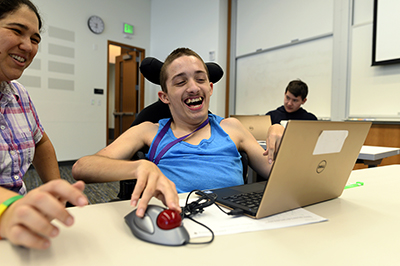
We assisted with the Robotics workshop, where we helped Scholars work together to create robots that would help teenagers manage stress. In this workshop, we discussed reasons for stress and ways we combat it and calm ourselves every day. After compiling information, we drafted ideas for social robots that we could use in our daily lives.
We used an interactive interface that allowed Scholars to design faces that they assumed would reduce stress and help other teenagers work through stress. The most common trait in each robot was that they played calming music that promoted the user to feel less stressed. Scholars were also able to give vital feedback to graduate students about their robot and how to make it both more appealing and accessible for students with disabilities.
We appreciate Maru’s guidance and energetic attitude during our sessions. She was able to guide Scholars and encourage them through their problems successfully. We also thank Maya for all of her behind the scene work she did to make this workshop successful.
Studying BCIs at the CNT
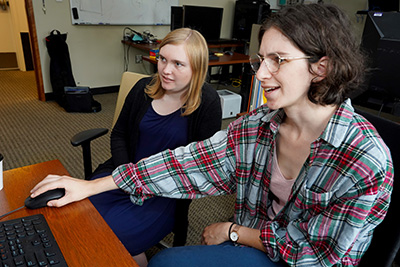
Brain-computer interfaces (BCIs) have a promising ability to enhance our future as a society. BCIs are capable of so much, such as being able to control a robotic arm with just a person’s mind. To do this, the BCI must decode a user’s intent and then provide information back to the user, which is actually extremely difficult to accomplish.
One-way neurotechnologists at the Center for Neurotechnology (CNT) are investigating this task is through stimulating over the somatosensory cortex of the brain to provide tactile feedback to the user. This could be useful if the user wanted to know what position the robotic arm was in, or how tightly it was gripping an object, in order to adjust to accomplish a specific task. Neurotechnologists are exploring the optimal time to stimulate the brain to provide tactile feedback. Through examining data, it has been suggested that normal touch is most easily detected when the brain’s alpha waves are in part of the cycle called the “trough” phase.
I used this information in my own experiment to determine if the same was true for sensorimotor direct cortex stimulation. Just like how songs are made up of many sound waves or frequencies, neural signals are also made up of different waves, and the ones we are interested in, the alpha waves, have a frequency of between around 8 to 12 hertz.
Direct cortical stimulation was applied to the somatosensory cortex of three participants implanted with specific grids, and neural signals were recorded from the surrounding electrodes. For each experiment, a different frequency of stimulation was used over the same length of time. If the participant was able to feel something in the part of their hand mapped to where the stimulation was evoked three times in a row, the amplitude of stimulation would decrease. If they were unable to feel anything, the amplitude would increase. For each experiment, this process was done 60 times, ten of which were catch trials where no stimulation was applied.
After all the data was collected, I then created a 3-D array of the desired information, which allowed us to extract the phase of the alpha wave at the beginning of the stimulation for each trial, which we then plotted on separate polar histograms in order to see if there was any correlation between the subjects’ responses and the phase of their alpha waves.
After running the polar histograms of the alpha wave phase for yes vs no responses through a nonuniformity test, it was concluded that there were no real clusters in the data, and therefore we cannot definitively prove or disprove our hypothesis from these results. This outcome was not what we expected, since previous research has shown that perception of normal touch seems to have a dependency on the brain’s alpha waves being in the trough phase. To confirm any other conclusions we may have, more data would need to be collected. This might entail analyzing each electrode separately or separating different trials by voltage amplitude, both of which were not done in our experiment. However, this experiment brought to light many options to continue to study, bringing to light that the process may be completely different than normal tactile sensations. Further proving this new idea may help us better understand how to utilize artificial sensation to improve brain-computer interfaces in the future.
As for how this experience has influenced my future as a college freshman, it has helped me understand how interconnected the subjects of computer science and neuroscience are. This summer I learned a new coding language and analyzed neural data, both of which were extremely interesting and rewarding. I also spent time at DO-IT Summer Study, where I could live independently in a dorm. I have complete confidence that I will have no problem going to college across the country. Overall the experience was invaluable; I am now more prepared for life at college and better understand how my computer science and neuroscience are deeply intertwined.
Christopher Caulfield Researches Augmented Reality
AccessComputing Team member and recent Cornell graduate, Christopher Caulfield, has gained some attention for his thesis project about developing augmented reality (AR) software for people who are Deaf or hard of hearing (DHH).
Caulfield and another student, Devon Bain, created an application that can be used to caption one-on-one conversations using off-the-shelf AR technology. Their prototype uses computer vision and facial recognition to display captions under the speaker’s face. This helps people who are DHH maintain eye contact and makes conversations more natural than when captions are displayed on a phone or tablet. AccessComputing partner Shiri Azenkot worked with the students on this project.
This is just one example of how emerging technologies can be used for accessibility. Visit to read more about his thesis project.
Study Away Silicon Valley
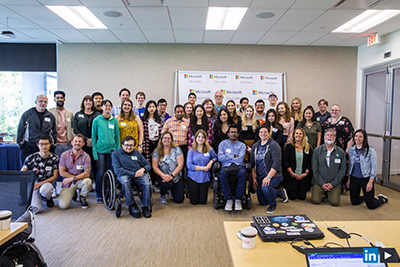
Twenty-five students, including three AccessComputing Team members, from seven different universities, traveled to Silicon Valley from May 20 – 24, 2019, to participate in the Teach Access program Study Away Silicon Valley (SASV). The participants visited the accessibility teams at Walmart, Google, Microsoft, Apple, Verizon Media Group, and Facebook where they learned how each company makes their products and services more accessible and usable. AccessComputing collaborators and partner representatives Kendra Walther and Rob Parke from the University of Southern California, Paul Ruvolo from Olin College of Engineering, and Li Liu from California State University, Northridge joined me as faculty mentors. In addition, there were faculty mentors from Michigan State University and University of Colorado.
Each of the participating companies also provided mentors. One of the mentors from Apple was Jordyn Castor, former student at Michigan State. In her presentation she recalled her first programming experience as a 14-year-old at the National Federation Blind Youth Slam where she programmed chatbots in a workshop sponsored by AccessComputing. She said that this experience led to her excitement about computing and to becoming a computer science major in college.
The students also participated in a week-long design activity where they were divided into six groups with mixed backgrounds (computer science and UX design) and different levels of knowledge about accessibility (little to extensive). Each group met for an hour or two per day to develop an accessibility solution. The week ended with each group giving a presentation about their design. It was very clear that students learned a lot about accessibility during the week.
STEM for All Video Showcase
During the week of May 13th, the 2019 STEM for All Video Showcase took place online, bringing together 800 presenters to share 242 short videos highlighting innovations in STEM education. The showcase had a very broad reach, including nearly 50,000 unique visitors from 158 countries.
This year, AccessComputing included a video on teaching accessibility. Viewed more than 500 times, the video covered the need for universities to teach about accessibility in computing and information courses, to prepare future software engineers to create more accessible software. The video shared some of AccessComputing’s research on barriers to teaching accessibility, which shows that many higher education computing faculty are interested in teaching about accessibility, but don’t feel they have the necessary expertise or the materials. The video also shared successful examples of integration, such as interleaving knowledge about web accessibility and screen readers in web development courses.
The discussion of the video show case was wide ranging. Many shared ideas about how to integrate accessibility into CS curricula. Some shared their personal experiences teaching about accessibility. Others discussed opportunities to teach accessibility alongside ethics and policy and the importance of integrating it in the earliest computing courses that students take.
Three New Features in Able Player 4.1
Originally published in AccessComputing News, the full version of this article discusses the three new features originally released in Able Player 4.0. However, since then, a newer version of Able Player has been released, with several bug fixes and smaller features.
Able Player is a free, open source HTML media player created with accessibility in mind by me, University of Washington technology accessibility specialist Terrill Thompson, and supported in part by AccessComputing.
Version 4.0 and 4.1 include three important new features:
Able Player now supports Vimeo, though a Plus, Pro, or Business account is required to hide Vimeo’s default controller, and captions are hosted by Vimeo.
There is now full support for audio and video playlists.
Able Player now uses Web Speech API to read text-based audio description, which enables Able Player to resume playback when an audio description is done being read.
To read more in-depth on these new features, see the full article online. Now that Able Player 4.1 is out, our next steps, both actively underway, are to create an Able Player WordPress plugin and an Able Player module for Drupal 8. These tools will make it much easier for content authors to add accessible videos to their web pages, and will increase adoption and enable accessible video to proliferate throughout the web.
About DO-IT
DO-IT (Disabilities, Opportunities, Internetworking, and Technology) serves to increase the successful participation of individuals with disabilities in challenging academic programs and careers, such as those in science, engineering, mathematics, and technology. Primary funding for DO-IT is provided by the National Science Foundation, the State of Washington, and the U.S. Department of Education.
For further information, to be placed on the DO-IT mailing list, request this newsletter or other materials in an alternate format, or make comments or suggestions about DO-IT publications or web pages, contact us at
DO-IT
University of Washington
Box 354842
Seattle, WA 98195-4842
doit@uw.edu
www.uw.edu/doit/
206-685-DOIT (3648) (voice/TTY)
888-972-DOIT (3648) (toll free voice/TTY)
509-328-9331 (voice/TTY) Spokane
206-221-4171 (fax)
Founder and Director: Sheryl Burgstahler, Ph.D.
Program Manager: Scott Bellman